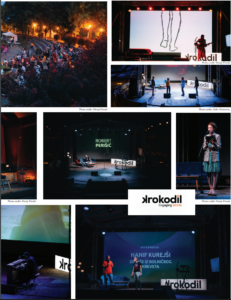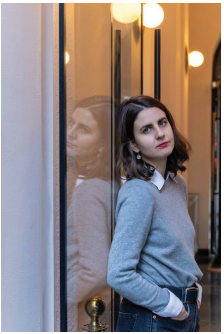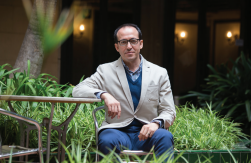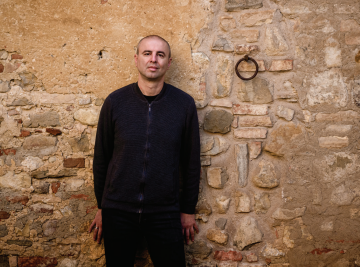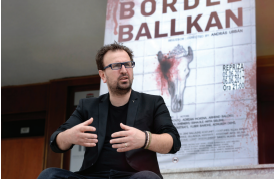Tanja Šljivar (1988, Banjaluka, SFR Yugoslavia)
studied dramaturgy at the faculty of drama arts
in Belgrade and applied theater studies at JLU in
Giessen. Her plays have been publicly read and
produced in professional theaters in Bosnia and
Herzegovina, Croatia, Serbia, Albania, Spain,
Poland, Austria, Finland, Slovakia, USA, and
Germany. She won several awards for her playwriting
and has been a guest at writing residencies in Austria,
Kosovo, Croatia, Czechia, Hungary, and Spain. In
2019, she worked as an artistic director of the drama
department at the National theater in Belgrade. She
teaches playwriting at the University in Belgrade
and has also taught at Universities in Banjaluka
and Vienna. In Germany, she is represented by the
Henschel Schauspiel agency
The title of the play comes from the 1978 New German Cinema film Deutschland im Herbst (Germany in Autumn) and is in conversation with the 1993 Böhse Onkelz band song of the same name. In 1977 members of the Baader-Meinhof gang kidnapped the German businessman Hans-Martin Schleyer, and Andreas Baader, Gudrun Ensslin and Jan-Carl Raspe were found dead in the prison cells of Stammheim. The police claimed that the three of them committed suicide. The term German Autumn was coined in response to these attacks which were carried out by the left-wing terrorist group Red Army Faction (RAF). The lyrics in the song “Deutschland im Herbst” replace the left-wing terrorism depicted in the movie with right-wing extremist attacks at the Rostock center for asylum seekers and the conflict between the police and nearly a thousand young far-right extremists. The “München” scene contains a brief paraphrase from the movie between the film’s director, Reiner Werner Fassbinder, and his mother Lilo Pempeit.
These vignettes are named after German cities. The lead actors in every scene are women from the Balkans; they are post-Yugoslav women artists who are temporary or permanent workers in the cultural sector of Germany. The director can determine how many actors will portray these characters; it can be anywhere from one to six or seven, or even more. Their experiences, manner and tropes of speech, language and appearance are all similar. They all discuss similar topics. In a way, they can be a single character. However, at times, they speak in sync, like a choir, which means a certain kind of polyphony is necessary for the performance and for the text. In addition to them, there are many divergent voices, which should not be taken as characters in the drama but as linguistic or ideological viewpoints. Sometimes, such as in the “Sinndelfingen/ Böblingen” scene, we hear a female voice that doesn’t have a name, a stance, or even a function. This voice is not ascribed to a particular role or to one of the artists, but rather to the playwright. Like all the other voices, it is fictionalized.
As needed, some of the city-scenes may be taken out, rearranged, or replaced upon approval from the playwright. However, if the production team chooses to edit the text, the city- scenes should be omitted entirely as opposed to being cut internally.
some believe
that left and right
can’t be mixed up
some believe in myth
“Direction,” Ernst Jandl
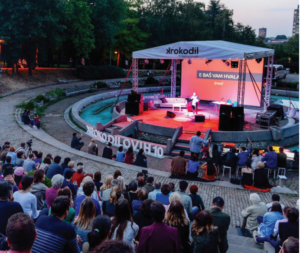
GRIEFSWALD
(The brutal North and a woman artist from the South)
Artist 4 was sent to a theater conference in a city in the north. She was pregnant by Poet. Or maybe that was a friend of hers, or a colleague, or some other post-Yugoslav woman artist. Maybe she had an abortion. Maybe none of them ever got pregnant or ever slept with this certain poet. Yet imagining a pregnant woman from the South walking along the northern landscape is a pleasant image. So, for now let’s just say that among all the women artists during their temporary or permanent stays in Germany, it was Artist 4 who, blessed with child, walked the shores of the Baltic Sea. She strolled the edges of a Hanseatic city, gazing at the Hagen-Friedrich billboards with their slogan “Entwurf und Design in Greifswald, Mode zu 100% in Deutschland hergestellt”—or “Concept and design from Greifswald. Fashion that is 100% made in Germany”—and their image of two heterosexual couples in white, lilac, blue, and yellow cotton t-shirts all bearing the logo that was a pair of black eagle wings.
The difference between the north and the south is the absolute difference in color, vibe, temperature of the air, temperature of the sea, temperature of fish stews, the type of fish that goes into those stews, and the difference between the excuses we give ourselves and others for our status and our sorrows. It’s the difference in how we pronounce words, how we bear temperature changes, our willingness or reluctance to go to a sauna, eat grilled octopus, or take a hot bath outdoors in sub-zero weather because it’s actually good for us and it is the exact opposite of what our southern grandmothers warned us—that it was deadly. The difference between the north and the south is first and foremost a difference in opinions that we have about ourselves; it is a difference in confidence.
Artist 4 walks holding her stomach, winded, like all pregnant women. She thinks of how before and after they had sex in the south, in their homeland, she and the poet had talked about this same thing: about the difference between the north and the south, how he writes about nothing other than the difference between the north and the south, how what he writes about allows him to live in the north, in a large Berlin flat only 225 km away. She could take a train, she thinks, go see him, and make a romantic surprise for him.
Artist 4 thinks about how her doctors often told her that she was the Mediterranean type, meaning dark and hairy, implying an excess of testosterone. She thinks about how the Greifswald woman who right now is jogging between her and the Baltic Sea is the Nordic type, which means blond, pale, and with a perfect ratio of estrogen and progesterone. She reads the names of the city streets; everything points to the likelihood that the brutal murder from the Broen series happened nearby, because the streets are named the Latvia Strasse because the streets are named the Copenhagen Strasse, because the streets are named the Riga Strasse. This is how the citizens of Greifswald pay respect to their neighbors, she thinks. Before and after making love, she used to talk with the poet about the names of the streets in the southern city where they met, in Split. She had thought that the Balkan Street from a Yugoslav pop song was the actual Balkan Street in Belgrade, and how that must have also been the Balkan Street in Split—after all, the band was from Split—and that was how the people of Split showed respect to the collective and shared cultural and geographical space of Yugoslavia. She thought how the Balkan Street from that song is now called the Vukovar Street, how the ideology of the citizens and the city is determined yet again, and again.
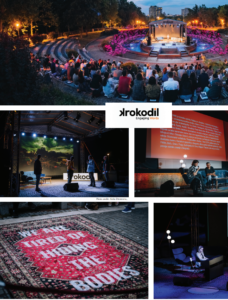
SINDELFINGEN/BÖBLINGEN
(On Yugoslav-German aunties)
Back in the ‘90s, with slow and precise clutch/brake pressure, auntie from Sindelfingen would start her Mercedes station wagon—Mercedes being the undisputed symbol of the Gastarbeiters domination over family members who remained back home. The auntie lived in Sindelfingen precisely because that’s where Mercedes headquarters were located. She drove the Mercedes to the front yard of the village home with wooden tables, grapevines, pigs, a summer kitchen, planters with lush flowers and us barefoot kids. We all looked at her speechless. Auntie from Sindelfingen stopped talking with the other auntie from Böblingen decades ago. The two of them had left to do ‘temporary’ work as young girls. One of them left legally after the agreement between the Socialist Federalist Republic of Yugoslavia and the Federal Republic of Germany—that gentlemanly agreement between Tito and Brandt—made it possible for half a million Yugoslav men and women to work in the newly capitalist Germany, destroying the myth of liberation and freedom from the Nazis at the hands of the Yugoslav Partisans, the victors now subjugated to building the roads and infrastructure of the defeated, to working in the German service sector, their blue collar sector, because back home in the south, in their victorious homeland, there was no work to be had. The other aunt left illegally when she went to visit the one who was already there, to “help” her. That paradoxical ideological and economic victory of a capitalist country over a socialist one—regardless of the military-political victory of the socialist country over the capitalist one—was a bigger blow for the Yugo-German folks than the daily longing for home ever was.
With every visit during the ‘90s the auntie gave me 20, 50 or 100 Deutsche Marks “for some candy.”
AUNTIE (shoving money into the pocket of my shorts or shirt): Here you go, kiddo, buy yourself some candy.
That instruction on what the money should be spent on was always a little weird to me because in addition to the money, she always brought tons of candy—delicious German half-pound milk chocolate bars with whole hazelnuts, which she bought over there with some other money, not the money she stuck into my pocket. I’d fantasize about what else I wanted to spend the cash on, but that was impossible because Grandma and Mom would always get a hold of it first. That was the other old unspoken agreement among these ladies, an agreement between Gastarbeiter women and their cousins—who, for example, lived in Bosnia. There was this mutual acknowledgment of the poverty and destitution of cousins, and the prosperity of Gastarbeiters. So it was logical that the ones who were better-off helped out those who were somewhat worse off, but they did so without ever saying a word. To avoid shame and humiliation, children served as money couriers between cousins’ families. Still, a child never quit wondering why she didn’t get to buy any candy, she never stopped hoping that Grandma and Mom wouldn’t find out that the money was in her pocket.
The aunties remained forever skinny because they smoked a lot and worked a lot. One of them now owns a Croatian restaurant in Böblingen—as if she or any other guest worker over there ever cared about which particular type of Yugoslav cuisine it was. For her and the rest of them, it was simply “our” cuisine, and that’s the truth.
Sindelfingen and Böblingen are the only German cities my grandma ever visited. She took a bus there and she got two photos, two polaroid shots, with two aunties, to prove it. This was back when they all still spoke to one another. Aside from that, Grandma never traveled abroad. Before I first visited Germany, I used to look at those photographs with a longing. I envied Grandma who sat on the bus for 24 hours to get to the cousins just to spend the day dusting, scrubbing floors, cooking, hanging laundry, ironing clothes, making beds, and then returning home two weeks later. She went to “help” them.
About 30 years later the auntie helped me move from Köln to Giessen in her minivan. When we arrived to the dorms at Grünberger Strasse, to my 11 square-foot room, my auntie thought that for a 25-year-old who had already completed one master’s degree “back home” the place was beneath me.
AUNTIE: “Hey, kiddo. Why don’t you come to Beblingen and stay with me?”
She used to pronounce the name of that city just like all the other Yugo-Gastarbeiters did: Beblingen. In the wet mouths of Yugoslav immigrants, the “Ö” would always become a short “e.” And that is how all of us—I, my aunt, and all of them—learned how to speak German.
English translation: Andrea Jurjević
